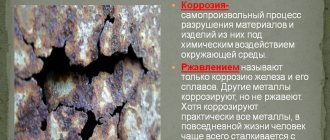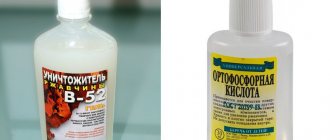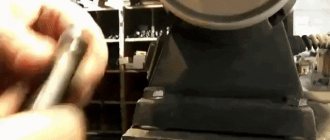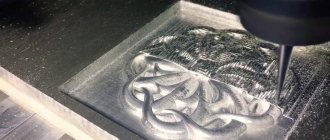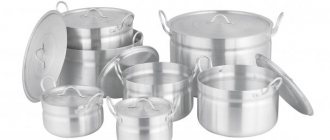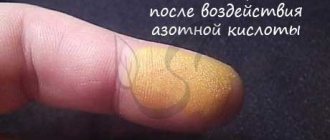Does aluminum rust in water?
Aluminum was first produced only at the beginning of the 19th century. This was done by physicist Hans Oersted. He conducted his experiment with potassium amalgam, aluminum chloride and mercury.
By the way, the name of this silvery material comes from the Latin word “alum”, because it is from them that this element is mined.
Alum [Wikimedia]
Alum is a natural metal-based mineral that combines sulfuric acid salts in its composition.
Previously, aluminum was considered a precious metal and was worth an order of magnitude more expensive than gold. This was explained by the fact that the metal was quite difficult to separate from impurities. So only rich and influential people could afford aluminum jewelry.
Japanese aluminum decoration [Wikimedia]
But in 1886, Charles Hall came up with a method for extracting aluminum on an industrial scale, which dramatically reduced the cost of this metal and made it possible to use it in metallurgical production. The industrial method involved the electrolysis of molten cryolite in which aluminum oxide was dissolved.
Aluminum is a very popular metal, because many things that people use in everyday life are made from it.
Application of aluminum
Due to its malleability and lightness, as well as its resistance to corrosion, aluminum is a valuable metal in modern industry. Aluminum is not only used to make kitchenware; it is widely used in automobile and aircraft construction.
Aluminum is also one of the most inexpensive and economical materials, as it can be used endlessly by melting down unwanted aluminum items, such as cans.
Aluminum cans
Aluminum metal is safe, but its compounds can be toxic to humans and animals (especially aluminum chloride, acetate and sulfate).
Physical properties of aluminum
Aluminum is a fairly light, silver-colored metal that can form alloys with most metals, especially copper, magnesium and silicon. It is also very plastic; it can easily be turned into a thin plate or foil. The melting point of aluminum = 660 °C and the boiling point is 2470 °C.
Chemical properties of aluminum
At room temperature, the metal is coated with a durable film of aluminum oxide Al₂O₃, which protects it from corrosion.
Aluminum practically does not react with oxidizing agents due to the oxide film that protects it. However, it can be easily destroyed so that the metal exhibits active restorative properties. The aluminum oxide film can be destroyed with a solution or melt of alkalis, acids, or with the help of mercury chloride.
Due to its reducing properties, aluminum has found application in industry for the production of other metals. This process is called aluminothermy. This feature of aluminum is its interaction with oxides of other metals.
Aluminothermic reaction involving iron (III) oxide [Wikimedia]
For example, consider the reaction with chromium oxide:
Cr₂O₃ + Al = Al₂O₃ + Cr.
Aluminum reacts well with simple substances. For example, with halogens (except fluorine), aluminum can form aluminum iodide, chloride, or bromide:
2Al + 3Cl₂ → 2AlCl₃
With other non-metals such as fluorine, sulfur, nitrogen, carbon, etc. aluminum can only react when heated.
Silver metal also reacts with complex chemicals. For example, with alkalis it forms aluminates, that is, complex compounds that are actively used in the paper and textile industries. Moreover, it reacts as aluminum hydroxide
Al(OH)₃ + NaOH = Na[Al(OH)₄]),
and metallic aluminum or aluminum oxide:
2Al + 2NaOH + 6Н₂О = 2Na[Al(OH)₄] + ЗН₂.
Al₂O₃ + 2NaOH + 3H₂O = 2Na[Al(OH)₄]
Aluminum reacts quite calmly with aggressive acids (for example, sulfuric and hydrochloric acids), without ignition.
If you dip a piece of metal into hydrochloric acid, the reaction will be slow—at first the oxide film will dissolve—but then it will speed up. Aluminum dissolves in hydrochloric acid, releasing hydrogen. The reaction results in aluminum chloride:
Al₂O₃ + 6HCl = 2AlCl₃ + 3H₂O
2Al + 6HCl → 2AlCl₃ + 3H₂.
Aluminum chloride [Wikimedia]
Here you will find interesting experiments to study the chemical properties of metals.
Reaction of aluminum with water
If you put aluminum shavings in ordinary water, nothing will happen because the aluminum is protected by an oxide film that prevents this metal from reacting.
Only by removing the protective film with mercury chloride can you get the result. To do this, the metal must be soaked in a solution of mercuric chloride for two minutes, and then rinsed well. The result is an amalgam, an alloy of mercury and aluminum:
3HgCI₂ + 2Al = 2AlCI₃ + 3Hg
Moreover, it does not stick to the metal surface. Now, by immersing the purified metal in water, you can observe a slow reaction, which is accompanied by the release of hydrogen and the formation of aluminum hydroxide:
Ways to combat aluminum corrosion
Aluminum is a metal widely used in industry and everyday life. Aluminum does not oxidize in air. Its inertness is due to the thin oxide film that protects it. However, under the influence of certain environmental factors, this metal is still subject to destructive processes, and corrosion of aluminum is not such a rare phenomenon.
Types of corrosion
Aluminum oxidizes quickly in the atmosphere, but to a shallow depth. This is prevented by a protective oxide film. Oxidation accelerates above the melting point of aluminum.
If the integrity of the oxide film is compromised, aluminum begins to corrode.
The reasons for the thinning of its protective layer can be various factors, from exposure to acids, alkalis and ending with mechanical damage.
Aluminum corrosion is the self-destruction of metal under the influence of the environment. According to the flow mechanism, they are distinguished:
- Chemical corrosion - occurs in a gas environment without the participation of water.
- Electrochemical corrosion – occurs in humid environments.
- Gas destruction - but accompanies heating and hot processing of aluminum. As a result of the interaction of oxygen with metals, a dense oxide film appears. This is why aluminum does not rust, like all non-ferrous metals.
On video: electrochemical corrosion of metals and methods of protection.
Causes of aluminum corrosion
The corrosion resistance of aluminum depends on several factors:
- purity - the presence of impurities in the metal;
- exposure environment - aluminum can be equally susceptible to destruction in clean rural air and in industrially polluted areas;
- temperature.
In many cases, low-concentration acids can dissolve aluminum. The natural oxide film does not protect against corrosion.
Powerful destroyers are fluorine, potassium, sodium. Aluminum and its alloys corrode when exposed to chemical compounds of bromine and chlorine, lime and cement solutions.
Corrosion of aluminum and its alloys occurs in water, air, carbon and sulfur oxides, and salt solutions. Sea water leads to accelerated destruction. Aluminum is considered an active metal, but it also has good corrosion properties.
There are two main factors that influence the intensity of the corrosion process:
- degree of aggressiveness of the acting environment - humidity, pollution, smoke;
- chemical structure.
Application of metal protective coatings
Our company is working in this direction. Among the most common types of compounds is zinc.
It is applied to the metal in a layer up to 200 microns thick. This creates good protection against contact with the environment.
Another advantage is that such material can be painted.
A wide variety of products are galvanized, including the bottoms of sea vessels.
Surface cleaning
The process is very important because it allows you to remove scale. As we said above, its presence can speed up the negative process several times.
High temperatures, chemical etching and sandblasting can be used to remove scale.
Low doping
Changing the very nature of steel is one of the effective methods for combating corrosion. According to research, steels with a high nickel content deteriorate especially quickly, while adding copper helps make the structure much more durable.
Creation of additional electrochemical protection
It can be of two types - from an external current source or from a protector. In this case, it is possible to stop the formation of pores and the occurrence of the electrochemical process, which poses a great danger to materials.
All of the methods listed are used locally. In this case, the likelihood of metal damage will be much lower. The issue of selection of materials and proper design is also very acute.
Does aluminum rust: properties of the material, causes of corrosion and methods of protection
Aluminum is a material that people often use in industry and for their own needs. This metal is flexible and resistant to external influences. It is non-toxic and safe for human health. Silver color allows the metal to be used for various purposes. These are industry and household spheres.
When working in industry, people often wonder if aluminum rusts. Everyone knows that if damage appears on a sheet, corrosion can develop. You should learn why aluminum rusts differently than other alloys. It is necessary to find out the reasons why it is subject to corrosion. Read about all this and more in our article today.
Properties
There's fire all around! I don’t know the meaning of the word, but I feel it’s burning
Let's study the characteristics of aluminum. The described metal melts at a temperature of 659 degrees Celsius. The density of the substance is 2.69*103 kg/cm3. Aluminum belongs to the group of active metals. Resistance to corrosion processes depends on a number of factors:
- Purity of the alloy. For the production of various equipment, metal is taken that is distinguished by its purity. It should not contain various impurities. Aluminum grades AI1 and AB2 are widely used.
- Environment in which aluminum is located.
- What is the concentration of impurities in the environment surrounding aluminum.
- Temperature.
- The pH of the environment has a great influence. You need to know that aluminum oxide can form when the pH is in the range between 3 and 9. In an environment where an oxide film immediately appears on the surface of an aluminum sheet, corrosion processes will not develop.
- Interaction with any acid or alkali.
- Mechanical pressure. For example, friction or a strong impact, after which a scratch appears on the top layer of metal.
- There are industrial areas. In them, fuel breakdown products affect the oxide film and destroy it. The metal begins to deteriorate. A similar situation occurs in megacities, where fuel breakdown products will interact with sulfur, as well as carbon oxides. A similar process destroys the film on aluminum. After this kind of external exposure, aluminum undergoes corrosion.
- It should be remembered that chlorine, fluorine, as well as bromine and sodium can dissolve the protective layer of the metal.
- If construction mixtures come into contact with metal, it quickly begins to deteriorate. In this case, aluminum is adversely affected by cement.
- Does water rust aluminum? If it gets on the sheet, the metal may be subject to corrosion processes. It is important to clarify which liquid has an effect. Many people use a special alloy that is not susceptible to corrosion from water. It is called duralumin. A unique alloy is used together with copper, as well as manganese.
- In order for the corrosion-inhibiting properties of aluminum to be maintained, it is necessary to maintain the acid-base balance. The range should be between six and eight units.
- It is believed that pure metal, without impurities, better withstands aggressive environments. Scientists conducted experiments. Based on the results, we can say that alloys of pure aluminum (90%) are more susceptible to corrosion than an alloy containing 99% of this substance. In the first option, corrosion occurs 80 times faster than in the second alloy.
- To ensure that the metal does not lose its properties longer in an aggressive environment, it is treated with a special paint. You can use a polymer composition. After processing, an additional protective layer appears.
- If you add 3% manganese to the alloy during production, it will be possible to avoid corrosion of aluminum.
How is aluminum protected from corrosion?
Channel PROGRAMMER'S DIARY The life of a programmer and interesting reviews of everything. so as not to miss new videos.
Alloys of other metals are susceptible to rust. It manifests itself quite quickly.
If you create certain conditions for aluminum, it will not deteriorate for many years. To protect aluminum from corrosion, a special film is formed on it. It lays down in a thin layer, which ranges from 5 to 10 millimeters.
This coating consists of aluminum oxide.
The film is durable and gives the metal additional protection from external negative influences. Thanks to this layer, air and moisture do not enter the structure of the material. If the integrity of the oxide coating is compromised, then the process of aluminum corrosion begins. The metal loses its properties.
Causes of corrosion
When the question arises whether aluminum rusts, you need to think about the reasons leading to corrosion. Various external factors can accelerate this process. The reasons for the appearance of rust on aluminum can be the following:
What is electrochemical corrosion and can it occur on an aluminum sheet?
What are "patricians"? Historical information
Most often, the appearance of electrochemical corrosion is provoked by galvanic couples. Damage occurs at the junction of two different alloys. In this case, the rust will be clearly visible.
The important point is that only one metal deteriorates, and the second is the source of the corrosion process. In order not to be afraid of electrochemical corrosion, you need to use a magnesium alloy.
Due to electrochemical rust, experts do not recommend using ordinary iron when in contact with an aluminum body.
What factors can slow down the process?
There are a number of factors that slow down the corrosion process of aluminum, and some of them stop this phenomenon. The following are distinguished:
Under what conditions does aluminum deteriorate in air?
Alternativeity is the presence of a choice of possibilities
Some people wonder if aluminum rusts when exposed to air. If the oxide film on the top layer of metal is destroyed, the corrosion process may begin. As a result, rust may appear. Film growth tends to slow down in fresh air. It should be remembered that aluminum oxide has good adhesion to the metal surface.
If the sheet is stored in a warehouse, the film will be from 0.01 to 0.02 microns. If the metal comes into contact with dry oxygen, then the thickness of the oxide film on the surface will be from 0.02 to 0.04 microns. If aluminum is subjected to heat treatment, the film thickness changes. It will be equal to 0.1 microns.
Aluminum is considered to be durable enough to be used outdoors. For example, it is used in rural areas, as well as in remote industrial areas.
How does water affect the metal being described?
Corrosion of aluminum in water can occur from damage to the top layer and protective film. The high temperature of the liquid contributes to the rapid destruction of the metal.
If aluminum is placed in fresh water, then corrosion processes will practically not be observed. If you increase the water temperature, you may not notice any changes.
When the liquid heats up to a temperature of 80 degrees or higher, the metal begins to deteriorate.
The corrosion rate of aluminum increases if alkali gets into the water. The described metal is hypersensitive to salt. That is why sea water is destructive for it.
To use this metal in seawater, it is necessary to add magnesium or silicon to the liquid.
If you use a sheet of aluminum that contains copper, then corrosion of the alloy will occur much faster than that of a pure substance.
Is sulfuric acid dangerous for aluminum?
People wonder whether aluminum rusts in sulfuric acid. Such acid is potentially dangerous for alloys. It has pronounced oxidizing properties. They destroy the oxide film and accelerate metal corrosion.
An interesting point is that concentrated cold sulfur does not affect aluminum. If aluminum is heated, then metal corrosion processes can begin. In this case, salt appears, it is called aluminum sulfate. It is soluble in water.
Resistance of aluminum in nitric acid
The described metal is characterized by increased resistance when exposed to a solution of nitric acid. It is often synthesized to produce concentrated nitric acid.
What substances have no effect on aluminum?
Do not be afraid of corrosion processes if aluminum comes into contact with citric acid. Malic acid and fruit juice will not change the properties of its alloy. Oil has little effect on alloys that contain aluminum.
Will metal corrosion occur upon contact with alkali?
Do not allow aluminum to come into contact with various alkalis. They easily destroy the protective film on the top layer. The metal reacts with water, after which hydrogen begins to be released. The corrosion process occurs quickly in this case. Mercury and copper also have a detrimental effect on the protective layer of aluminum.
So, we found out whether aluminum rusts. As you can see, it does not always have good corrosion protection.
Source
Painting of aluminum products
Most manufactured products are protected by applying a layer of dyes. If the dyes are dissolved, then dyeing is called wet. If the dyes are dry, the procedure is often called powder coating.
Wet dyeing
Application of paint and varnish layers is possible after protecting the aluminum with a passivating primer, which contains zinc and strontium compounds. The primer is applied in two stages onto a carefully prepared metal base. After complete evaporation of the solvent from the primer mixture, the surface is covered with an insulating outer layer of oil or glyphthalic varnish. There are functional paint and varnish compositions that protect against chemicals, gasoline, and oils. To obtain colored decorative structures, hammer varnishes are used. With some protection technologies, bakelite varnish is applied under pressure to ensure that all micropores are filled. The choice of coating is determined by future operating conditions. Application technology is constantly being improved.
Powder coating
To use this method, the metal also needs to be cleaned of a layer of fat and other inclusions. Preparation is carried out by immersion in alkaline, slightly alkaline (almost neutral), and acidic solutions. Wetting agents are sometimes added to improve cleaning efficiency.
The next stage in the preparation of some aluminum structures is the formation of a conversion layer by treatment with chromate and phosphate compounds. Sometimes zirconium and titanium compounds are used. The need for this stage is determined by the specific features of the product. This is a matter of competence of technologists. Each stage of processing alternates with mandatory washing and drying of the material.
Then a polymer is applied, which performs a protective function. Polyesters are widely used. They form a dense layer that is resistant to chemical, mechanical, and thermal effects. Polymerized urethane coatings have greater hardness. Epoxy, polyester-epoxy, and acrylic powders are also used. They form a surface of any given color, structure, and ability to reflect light rays. The coloring powder is applied using the electrostatic or tribostatic method.
Electrostatically, pigment particles in the air (fluids) are charged by the action of electrodes. Tribostatically, paint grains are charged due to the frictional force produced by a special gun. The process is carried out in chambers. Unused powder is collected and returned to its original location. The stage ends with polymerization at high temperature.
Both types of aluminum coloring allow you to obtain colors that meet international standards. Some production requirements necessitate a sequential combination of two methods: anodic oxidation and painting. The number and essence of the methods used are determined by specialists.
Aluminum is believed to not rust. But this is not true. We tell you why
Aluminum is believed to not rust.
But this is not true. Let's tell you why. There is an opinion that aluminum does not rust or deteriorate in air. This is close to the truth, but not quite. Aluminum is actually more resistant to weathering than iron. But it can also corrode, losing its hardness and appearance.
In this article we will tell you why aluminum rusts and what measures are taken in production to avoid this.
Why does aluminum (not) rust?
The microstructure of aluminum is designed in such a way that it protects itself from corrosion. When exposed to air, free aluminum atoms on the surface “cling” to oxygen and form a film of aluminum oxide. It prevents the start of corrosion processes.
Aluminum structure
But the oxide film is not tank armor. It's more like a skin, like an apple. As long as the fetus is hidden inside, it is in no danger. If you bite into an apple and leave it on a plate, the damage will quickly begin to darken - those same oxidative processes will begin.
Much the same thing happens with aluminum. As long as the film maintains its integrity, everything is fine. But if it is violated, aluminum will also corrode. The oxide film is most damaged by mechanical influences and acidic and alkaline compounds in the atmosphere.
The most serious destroyers of aluminum are fluorine, potassium and sodium. They react with oxygen, as if pulling it out of the oxide film. The material's resistance to corrosion decreases. Bromine and chlorine compounds, lime solutions, and cement are also harmful to aluminum. The oxide layer is actively destroyed under the influence of salty sea air in coastal regions.
This is what rust looks like on old car wheels.
This is what rust looks like on old car wheels. Moreover, the “ideal” oxide film is formed only in laboratory conditions with pure aluminum and pure air. In real industry, aluminum-based alloys are commonly used. And air most often contains a whole bunch of different compounds.
The same car wheels are usually made from alloys containing silicon. Silicon makes the material more fluid - this is important when melting disks. Plus it increases the wear resistance of the product.
Anti-corrosion properties depend on the composition of the aluminum alloy.
Increasing the anti-corrosion properties of aluminum
In industry, anodizing is used to improve the anti-corrosion properties of aluminum.
This method solves two problems at once:
Multi-colored anodized aluminum profile
When anodizing, the natural oxide film is removed from the surface and a new one is created - much thicker and stronger. The natural oxide layer usually does not exceed 0.01 microns.
Anodizing allows you to create a protective coating up to 25 microns thick. This is no longer an apple peel, but a real nut shell. It is much more difficult to damage it.
Therefore, anodized aluminum is much more durable than regular aluminum.
Aluminum anodizing process
There are several anodizing technologies. The Novametaltrade workshops use the following approach:
Degreasing.
The rolled product is immersed in a bath of surfactant, which removes dirt and oil stains. This stage is needed to properly prepare the surface for the next one.
Etching.
The prepared rolled product is immersed in a bath with an alkaline solution, which destroys the natural oxide film and the top layer of pure metal.
Lightening.
As a result of etching, a thin layer of oxides of elements that are part of the alkaline solution remains on the metal surface. At this stage, the surface of the rolled product is cleaned of heavy metals and prepared directly for anodizing.
Anodizing.
The rolled product is placed in a conductive medium, and anodic polarization is performed. As a result, a durable porous film grows on the surface, which provides the material with high corrosion resistance.
Absorption staining.
The rolled product is placed in a medium containing a coloring pigment. The pigment penetrates into the formed pores, giving the surface an even, uniform color.
Seal.
This is the final technological stage. The rolled product is immersed in boiling water and kept there. Under this influence, the pores are reliably clogged. Now the pigment is not washed out from the surface under the influence of external factors, and the material retains its appearance for a long time.
Automated line for anodizing rolled aluminum
The anodizing process can produce coatings of varying thicknesses.
Anodized aluminum of classes 5 and 10 is used for products designed for indoor use.
Classes 15 and 20 are used for architectural structures.
The highest class 25 is used for products that are used in particularly harsh atmospheric conditions: in coastal regions, near aggressive environments, in rooms with polluted air (for example, in production workshops), etc.
Subscribe to the channel if you want to know even more about metallurgy and metal products.
Novametal Trade is one of the leading manufacturers of rolled metal and metal products in Russia. On the market since 2010.
The article uses images from the Yandex.Images service
Corrosion of aluminum and its alloys. Methods for combating and protecting aluminum from corrosion
Low density and mechanical strength, combined with satisfactory corrosion resistance, make aluminum an attractive structural material that is widely used in construction.
However, from a chemical point of view, aluminum is one of the most reactive metals, which actively interacts not only with acids and alkalis, but also with water! The apparent contradiction is very simply explained: under the influence of oxygen (or other oxidizing agents), the surface of metallic aluminum is covered with a durable, chemically stable oxide film, which protects the metal from destruction. This phenomenon is called passivation. A metal is passive when it does not undergo changes when interacting with a potential source of corrosion, and is active when an aggressive substance destroys it.
Let us recall that corrosion is the process of destruction of metals and their alloys as a result of chemical or electrochemical exposure to the environment.
A metal that is resistant to corrosion in one environment may be resistant to corrosion in another. For example, aluminum is resistant to corrosion caused by liquid fuels, and is not resistant to the action of sodium alkali (the so-called phenomenon of passivity and activity).
Aluminum oxide creates a chemically inert protective layer, the thickness of which is 20-100Å. Aluminum, the surface of which is cleared of the protective film, can react with water, releasing hydrogen. Under the influence of oxidizing agents, the surface of aluminum is passivated, so oxygen contained in the air or dissolved in water increases its corrosion resistance.
The corrosion resistance of aluminum largely depends on the content of impurities of other metals.
As is known, when two metals immersed in an electrolyte come into contact, a galvanic couple is formed, where the more active metal becomes the anode, and the less active metal becomes the cathode. As a result of the electrochemical reaction, the anode is destroyed.
Most impurities (with the exception of metals more active than aluminum) play the role of a cathode in relation to aluminum, i.e. contribute to its destruction.
For this reason, high purity aluminum has higher corrosion resistance than industrial metals, which in turn are more resistant to corrosion than aluminum alloys. In addition, the corrosion resistance of aluminum depends on the characteristics of the environment and the reactions caused by this environment in the aluminum.
Mechanical coating
How to protect aluminum from corrosion? The most commonly used mechanical method is applying a layer of paint.
Paint the product and you will see the effectiveness of this method. Painting can be wet and dry, or powder. These technologies will improve. In wet painting, paint layers are applied after protecting the aluminum with a composition containing zinc and strontium compounds. The metal base is carefully prepared: protected, polished, dried. The primer is applied in stages.
When the solvent from the primer mixture has completely disappeared, the surface can be coated with an insulating composition: oil or glyphthalic varnish.
How to protect metal from damage
The work uses several types of protective equipment, which include:
Use of special paints and varnishes
As with outdoor rust control, it is very important to prevent the corrosive environment from coming into contact with the metal. In this case, LMBs are perfect.
There are several types of materials that can be freely used in dyeing.
These include:
- Bitumen-based paints.
- Compositions with a phenol-formaldehyde base.
- Ethanol paints and varnishes.
Substances with an epoxy and coal tar base perform well. The main requirement is that they contain as few solvents as possible.
The main advantage of using such a product is its ease of application.
The paint is applied to the surface, the protected areas immediately become clearly visible.
For additional enhancement, protecting the effect from an aggressive environment, you can also use various oxides, including mercury and copper. In this case, the structure will not become overgrown with marine life.
In order for the application of paintwork materials to give the best results, the surface of the metal structure will need to be phosphated. Only after this is staining allowed.
It is also worth considering that it should be as thick as possible in order to last longer and maintain a noticeable effect.
Aluminum corrosion
Aluminum corrosion is the destruction of metal under the influence of the environment.
For the reaction Al3+ +3e → Al, the standard electrode potential of aluminum is -1.66 V.
The melting point of aluminum is 660 °C.
The density of aluminum is 2.6989 g/cm3 (under normal conditions).
Aluminum, although an active metal, has fairly good corrosion properties. This can be explained by the ability to passivate in many aggressive environments.
The corrosion resistance of aluminum depends on many factors: the purity of the metal, the corrosive environment, the concentration of aggressive impurities in the environment, temperature, etc. The pH of solutions has a strong influence. Aluminum oxide forms on the metal surface only in the pH range from 3 to 9!
The corrosion resistance of Al is greatly influenced by its purity. For the manufacture of chemical units and equipment, only high-purity metal (without impurities), for example, AB1 and AB2 aluminum, is used.
Corrosion of aluminum is not observed only in those environments where a protective oxide film is formed on the surface of the metal.
When heated, aluminum can react with some non-metals:
2Al + N2 → 2AlN – interaction of aluminum and nitrogen with the formation of aluminum nitride;
4Al + 3С → Al4С3 – reaction of interaction of aluminum with carbon with the formation of aluminum carbide;
2Al + 3S → Al2S3 – interaction of aluminum and sulfur with the formation of aluminum sulfide.
Corrosion of aluminum in air (atmospheric corrosion of aluminum)
Aluminum, when interacting with air, becomes passive. When pure metal comes into contact with air, a thin protective film of aluminum oxide instantly appears on the aluminum surface. Further, film growth slows down. The formula of aluminum oxide is Al2O3 or Al2O3•H2O.
The reaction of aluminum with oxygen:
4Al + 3O2 → 2Al2O3.
The thickness of this oxide film ranges from 5 to 100 nm (depending on operating conditions). Aluminum oxide has good adhesion to the surface and satisfies the condition of continuity of oxide films.
When stored in a warehouse, the thickness of aluminum oxide on the metal surface is about 0.01 - 0.02 microns. When interacting with dry oxygen – 0.02 – 0.04 microns.
When heat treating aluminum, the thickness of the oxide film can reach 0.1 microns.
Aluminum is quite resistant both in clean rural air and in an industrial atmosphere (containing sulfur vapor, hydrogen sulfide, ammonia gas, dry hydrogen chloride, etc.). Because sulfur compounds do not have any effect on the corrosion of aluminum in gas environments - it is used for the manufacture of sour crude oil processing plants and rubber vulcanization devices.
Corrosion of aluminum in water
Aluminum corrosion is almost not observed when interacting with clean, fresh, distilled water. Increasing the temperature to 180 °C does not have any special effect. Hot water vapor also has no effect on aluminum corrosion. If you add a little alkali to water, even at room temperature, the corrosion rate of aluminum in such an environment will increase slightly.
The interaction of pure aluminum (not covered with an oxide film) with water can be described using the reaction equation:
2Al + 6H2O = 2Al(OH)3 + 3H2↑.
When interacting with sea water, pure aluminum begins to corrode, because... sensitive to dissolved salts. To use aluminum in seawater, a small amount of magnesium and silicon is added to its composition. The corrosion resistance of aluminum and its alloys when exposed to sea water is significantly reduced if the metal contains copper.
Corrosion of aluminum in acids
As the purity of aluminum increases, its resistance to acids increases.
Corrosion of aluminum in sulfuric acid
Sulfuric acid (has oxidizing properties) in medium concentrations is very dangerous for aluminum and its alloys. The reaction with dilute sulfuric acid is described by the equation:
2Al + 3H2SO4(dil) → Al2(SO4)3 + 3H2↑.
Concentrated cold sulfuric acid has no effect. And when heated, aluminum corrodes:
2Al + 6H2SO4(conc) → Al2(SO4)3 + 3SO2↑ + 6H2O.
In this case, a soluble salt is formed - aluminum sulfate.
Al is stable in oleum (fuming sulfuric acid) at temperatures up to 200 °C. Due to this, it is used for the production of chlorosulfonic acid (HSO3Cl) and oleum.
Corrosion of aluminum in hydrochloric acid
Aluminum or its alloys quickly dissolve in hydrochloric acid (especially when the temperature rises). Corrosion equation:
2Al + 6HCl → 2AlCl3 + 3H2↑.
Solutions of hydrobromic (HBr) and hydrofluoric (HF) acids act similarly.
Corrosion of aluminum in nitric acid
A concentrated solution of nitric acid has high oxidizing properties. Aluminum in nitric acid at normal temperatures is extremely resistant (resistance is higher than that of stainless steel 12Х18Н9). It is even used to produce concentrated nitric acid by direct synthesis.
When heated, corrosion of aluminum in nitric acid proceeds according to the reaction:
Al + 6HNO3(conc) → Al(NO3)3 + 3NO2↑ + 3H2O.
Corrosion of aluminum in acetic acid
Aluminum is quite resistant to acetic acid of any concentration, but only if the temperature does not exceed 65 °C. It is used to produce formaldehyde and acetic acid. At higher temperatures, aluminum dissolves (with the exception of acid concentrations of 98 - 99.8%).
Aluminum is stable in bromic and weak solutions of chromic (up to 10%), phosphoric (up to 1%) acids at room temperature.
Citric, butyric, malic, tartaric, propionic acids, wine, and fruit juices have a weak effect on aluminum and its alloys.
Oxalic, formic, and organochlorine acids destroy metal.
The corrosion resistance of aluminum is greatly influenced by vapor and liquid mercury. After a short contact, the metal and its alloys intensively corrode, forming amalgams.

